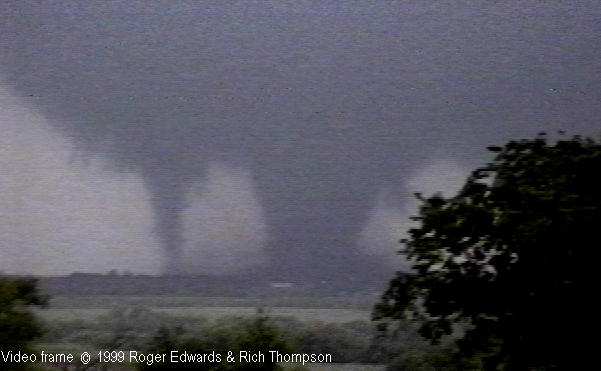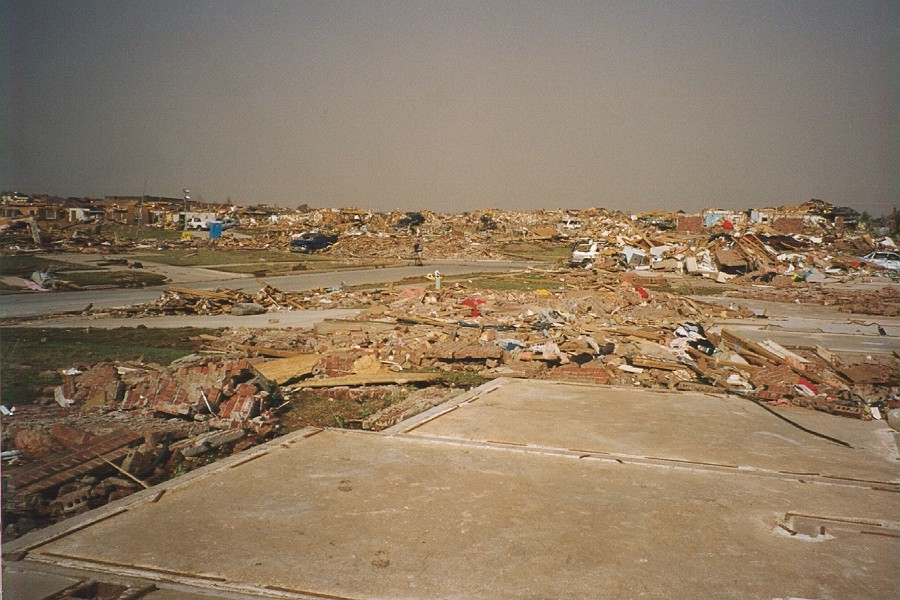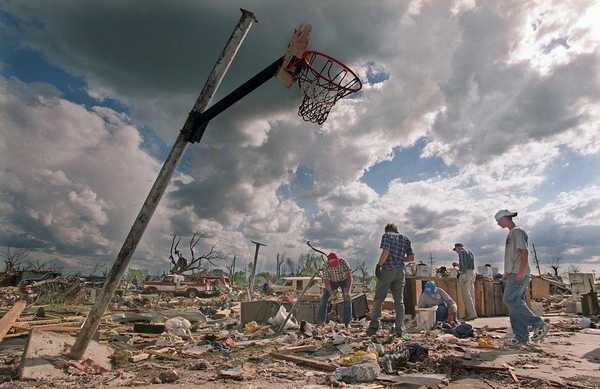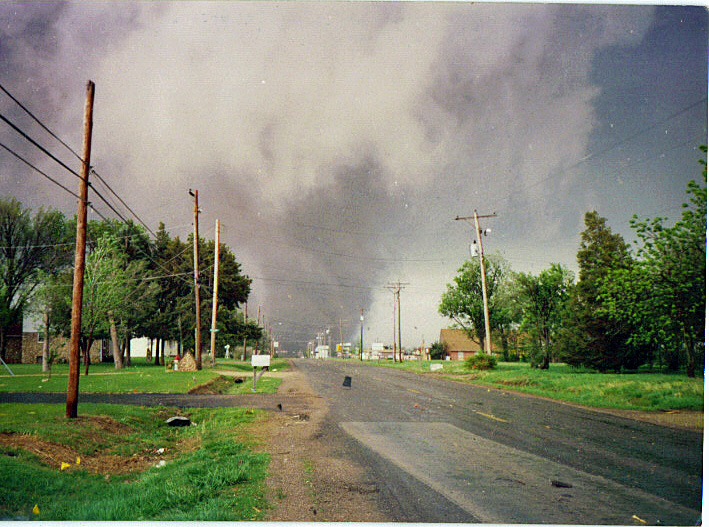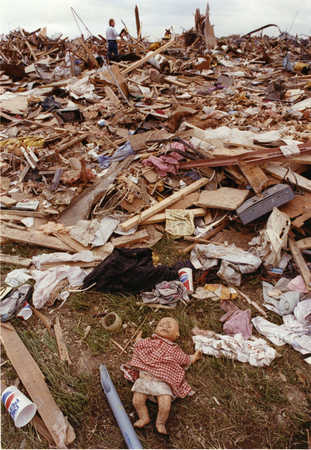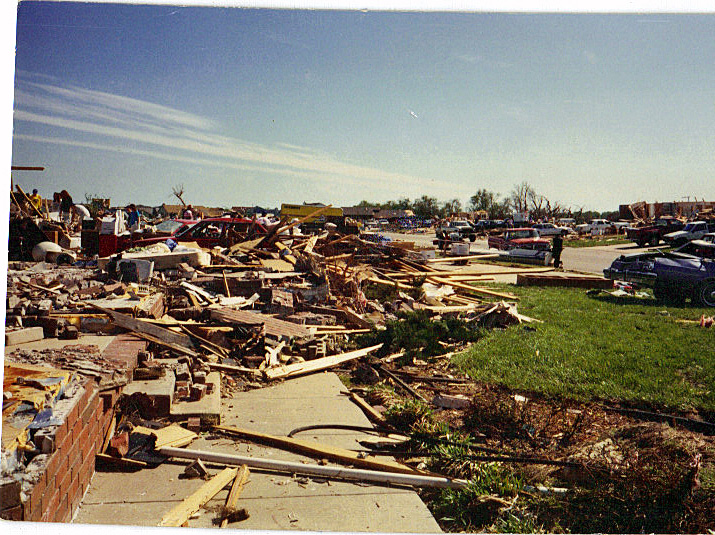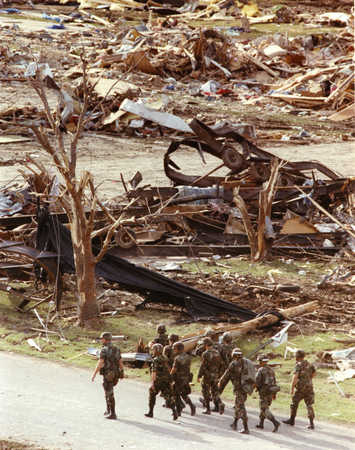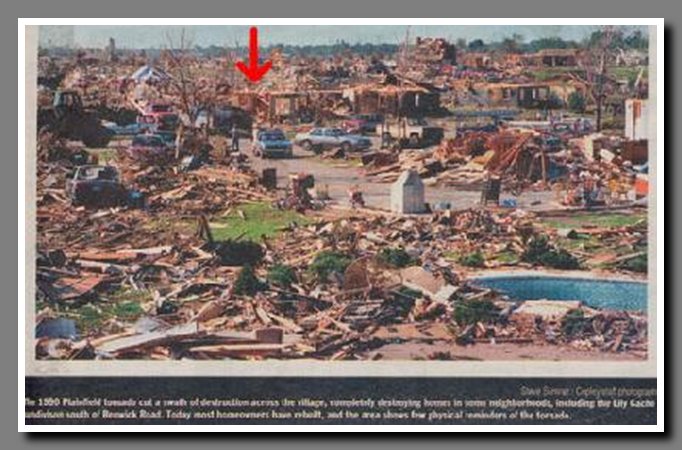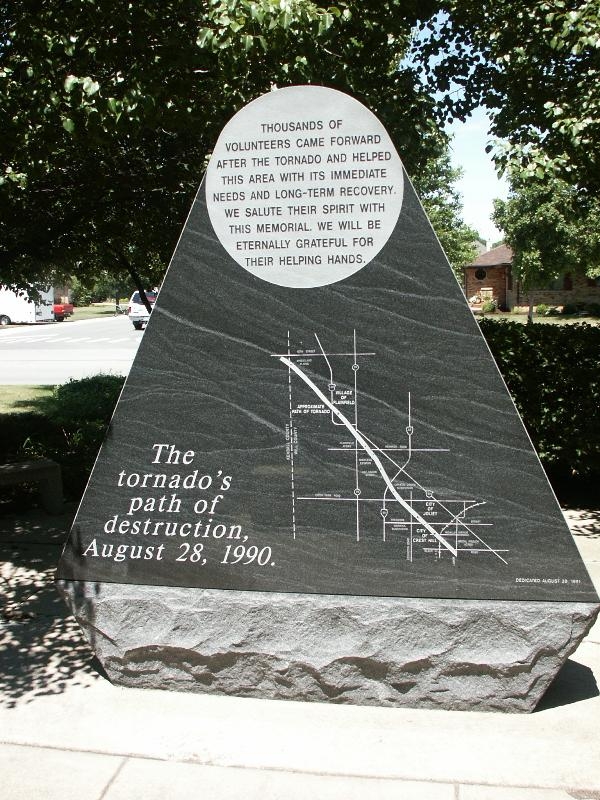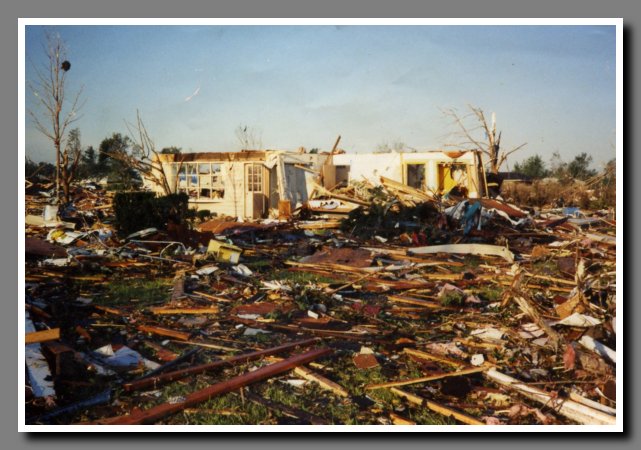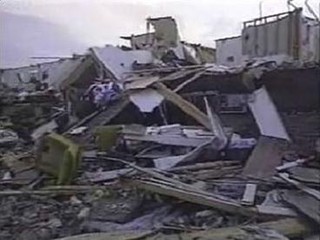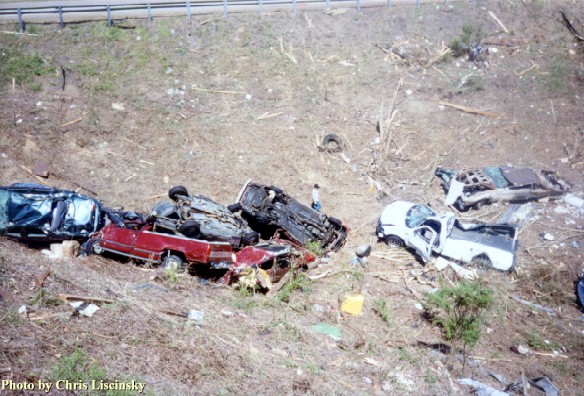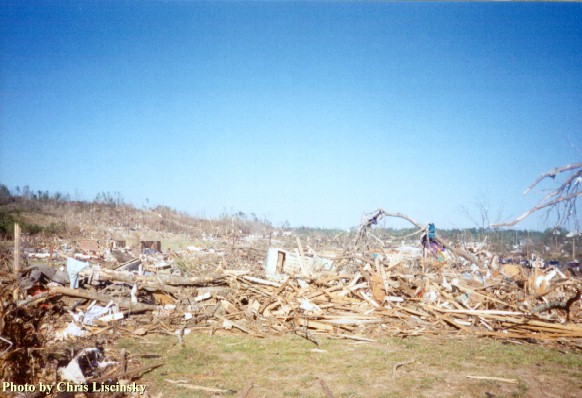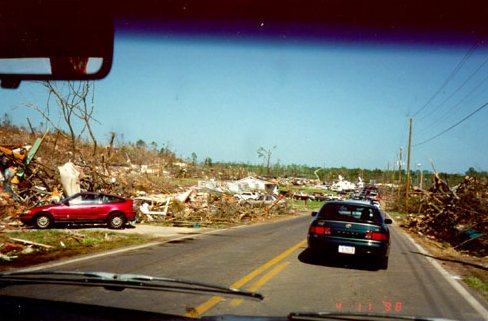Tornadoes of 1990-1999
1. Bridge Creek-Moore, OK Tornado
Date: May 3, 1999; Rating: F5
Part of the 1999 Oklahoma tornado outbreak. This monster tornado, one of 71 confirmed on May 3rd, devastated the Oklahoma City suburbs of Bridge
Creek and Moore. 36 people were killed, the most by one tornado since 1979. A nearby Doppler On Wheels (DOW) measured winds at a record setting 318mph. Much of
this torando was carried live by local Oklahoma news channels. Besides the fatalities, over 8,000 homes were badly damaged or destroyed, and the tornado caused 1.1 billion
dollars in damage (adjusted for inflation), making it the costliest tornado in American history. Excellent advance warnings likely saved many lives.
There were other notable tornadoes in the outbreak. Later in the evening of May 3, a monster tornado, one of the widest ever observed, hit the town of Mulhall hard, killing two and acheiving an F4 rating. Another
F4 hit the city of Haysville, Kansas on May 3, killing six people. The entire May 3-6 outbreak saw 140 tornadoes and 50 fatalities. The Bridge Creek-Moore tornado was the lone
F5 rated tornado in the outbreak, and is widely considered one of the most intense, or strongest tornadoes on record. Five other tornadoes in the outbreak were rated F4.
Other Websites
Wikipedia - 1999 Oklahoma tornado outbreak
National Weather Service - Great Plains tornado outbreak of May 3, 1999
Central Oklahoma Torando Intercept May 3, 1999 Roger Edwards
Youtube Videos
KXAN news of storm chasers on May 3 tornado.
Another video of May 3, 1999 Oklahoma City tornado.
May 3, 1999 by Tornadovideos.net
Amazing home video of tornado and debris.
2. Jarrell, TX Tornado
Date: May 27, 1997; Rating: F5
Part of the 1997 Central Texas tornado outbreak. Very unusual tornado. Supercell tracked southwest (most travel northeast). The Jarrell tornado went from a narrow rope
tornado to a 3/4 mile wide monster and tracked just under eight miles and killed 27 people in Jarrell. Double Creek Estates, both mobile homes and regular homes, suffered immense devastation from this very
slow moving tornado which literally sit over certain areas, grinding them in excess.
Grass and dirt in nearby fields was ripped out to depths of 18 inches. 500 feet of asphalt was peeled off of a road. In many cases, only slab foundations
were left where homes once stood. Two other tornadoes, rated F4 (Lake Travis) and F3 (Cedar Park), killed one person each. The damage from the Jarrell tornado is about as extreme as has been seen. Some think the F5 rating is
high and the extreme damage was caused by the time the tornado spent over the town, not by "top end" strength winds. Bottom line, the Fujita Scale is a DAMAGE scale, and
the damage from Jarrell was about as severe as is imaginable.
Other Websites
Wikipedia - 1997 Central Texas Tornado Outbreak
National Weather Service assessment of Central Texas Tornadoes
USA Today story about Jarrell tornado
Youtube Videos
Raw news footage of Jarrell tornado in early rope form.
CNN story on Jarrell tornado.
More raw footage of Jarrell tornado.
Dramatic home video of the Cedar Park tornado.
3. Andover, KS Tornado
Date: April 26, 1991; Rating: F5
On April 26, 1991 a major tornado outbreak of 55 tornadoes took place, mainly over Kansas and Oklahoma. 24 people were killed in the outbreak, with 17 killed by the most
severe and highest rated tornado of the outbreak, the Andover tornado. It began as a narrow tornado doing F2-F3 damage, but began to widen as it passed McConnell Air Force
Base (great video) and continued getting bigger and stronger, destroying many homes and devistating the Golden Spur Mobile Home Park, where most of the fatalities occured. Numerous
videos document this event due to Andover being a city of reasonable size, and the tornado hitting in the evening hours while there was ample light.
There were other severe tornadoes in this outbreak. The "Red Rock (Oklahoma) tornado" was rated F4, but stayed mostly over country, away from homes. It is also documented on
numerous videos, and had a then record high wind recording around 260 mph (surpassed in May 3, 1999 event). This tornado tracked 66 miles, the furthest of any tornado in the outbreak, and
reached a width of one mile at times.
The El Dorado Lake tornado (see below far right picture) was rated at just F2 and killed nobody, but it's video of a news crew and a young family taking cover under an overpass became famous, and has perhaps wrongly led others
to take shelter under overpasses, which is in fact a very bad idea (again, see May 3, 1999 tornado). Numerous other F2-F4 tornadoes were responsible for significant damage and additional fatalities, though no
one tornado killed more than one person aside from Andover.
Other Websites
1991 Andover, Kansas Tornado Outbreak
CDC review of April 26, 1991 tornado outbreak
Youtube Videos
Robert Prentice, damage survey of Andover tornado.
Various Andover videos, including McConnell Air Force Base video.
Misc. Andover videos from local news.
Famous El Dorado Lake overpass tornado video.
Warren Faidley video of Red Rock, OK tornado.
4. Plainfield, IL Tornado
Date: August 28, 1990; Rating: F5
This violent tornado, part of a rare August outbreak (12 tornadoes), killed 29 people and injured 350. It is the only F5 rated tornado ever to occur in August, and the only F5 tornado
near the Chicago area. The tornado came from a supercell storm moving southeast across the state, and touched down around 3:30pm and traveled 16 miles in just eight minutes
causing immense damage. Among the places hit, was Plainfield High School, where some students and faculty were on hand getting ready for the start of school just one day later (which
surely would have been more catostrophic). Three were killed at the school (none were students), and four others were killed elsewhere in Plainfield.
As the storm progressed into Joliet, several others were killed and several major structures sustained major damage. Next up was the town of Crest Hill, where eight more
were killed in an apartment complex and two more died in a car. One of the criticisms from this storm was a lack of warning from a then-overworked Chicago office of the National Weather
Service. There are also episodes of Storm Stories and It Could Happen Tomorrow that focus on the Plainfield tornado.
Other Websites
Wikipedia - 1990 Plainfield Tornado
Roy Taylor's page with videos of damage
MaryPat Gabor's Plainfield tornado page and amazing story
National Weather Service - Study of Chicago's significant tornadoes
Youtube Videos
History Channel piece on Plainfield tornado (quality not great).
John Scala looks back at Plainfield tornado.
5. Birmingham, AL Tornado
Date: April 8, 1998; Rating: F5
Another brutal tornado in a decade that saw several notable events, this one killed 32 people. The tornado, easily the most damaging of a four day outbreak, touched down
about 7:30pm (thus, few pictures of the tornado that I can find) and tracked for 31 miles, at times up to 3/4 of a mile wide, plowing through nine suburbs of
Birmingham, Alabama.
The suburb of Oak Grove saw some of the heaviest damage, including a high school destroyed. Near Rock Creek, several cars were blown hundreds of feet into
a ravine. Interestingly, had the tornado stayed on the ground just a few miles further, downtown sections of Birmingham would have been hit, as well as the airport. The outbreak
saw 34 people killed in Alabama, as well as seven in Georgia from tornadoes rating as high as F3. Birmingham has also seen major killer tornadoes in 1977 and 1956.
Other Websites
Wikipedia - April 1998 Birmingham Tornado
National Weather Service assessment of Birmingham Tornado
Youtube Videos
ABC 33/40 look back at Birmingham tornado.


